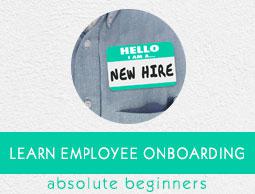Employee Onboarding - Engaging Program
Employee onboarding and engagement go hand in hand. Any program you implement needs to be engaging. The purpose of employee onboarding is to engage employees from the beginning. Onboarding is more than simple checklists; it engages new hires in the company culture and promotes a highly functioning team. When onboarding is done correctly, employees are more engaged and productive.
Onboarding is a hugely under-focused management issue, perhaps because the return isn’t immediate and the retention gains typically aren’t convincing. However, onboarding is directly tied to the organization’s talent, and if you don’t have great staff in place, things fall apart.

Early engagement of the new hire is critical to the success of the new employee orientation program. Employee engagement is no longer just about motivation to contribute as an individual but it is now aligned with employer business goals and customer requirements.
Involve the new hire in group activities with peers.
Schedule team lunches with senior members frequently. These are informal methods to gauge the engagement level of the new hires.
Organize team building activities involving other team members as well.
Aligning the new hire with the company goals and customer needs at the earliest is critical for their performance.
How to Create an Engaging Program?
Onboarding is all about getting new hires engaged. This is significant since there is an alarming amount of disengagement in the workplace.
The HR team can implement the following methods to build engagement into your onboarding efforts −
A Quick Survey for Employee − This will help provide a good baseline assessment to use for comparison purposes at the conclusion of formal onboarding efforts.
Creating Individual Career Growth Plans − Engagement comes from employees feeling like they are respected and have a stake in the success of the company. Creating career/growth plans helps because it not only gives new hires success benchmarks, but simply asking how you can support them builds loyalty.
Leaders Accountability − When an employee complains about work, the problem often is not with the job; it’s with the manager. The shortage of good, quality mentors and leaders in the work force today is directly proportional to the shortage of employee loyalty. It’s a cause and effect relationship.
Explaining the Future Plans − Satisfied employees are getting a paycheck, but engaged employees are contributing to your mission. To be engaged, your employees need to know their performance targets and the mission of the company beyond making money.
The truth is that most employees aren’t inherently disloyal; they are simply searching for work that is both satisfying and engaging. It’s important to note that job satisfaction and engagement isn’t the same thing. Satisfied employees will keep the company afloat, but engaged employees will help the organization grow.
Different Ways of Engaging Employees
As a manager, keeping your employees engaged is perhaps the biggest challenge you face. It’s also a huge opportunity to gain long term commitment and discretionary effort from your team. That effort will ultimately lead to higher productivity.
The HR team can resort to the following strategies to create a more effective and more engaging onboarding experience −
Starting Ahead
There’s not much that’s less engaging than spending hours filling out paperwork. Speed up the onboarding process by allowing new hires to complete paperwork in advance so their first day or two begins with learning about the company culture and getting to know their new colleagues.
Spreading Out
Don’t be fooled into thinking it’s a good idea to squeeze the entire onboarding process into just one week so employees can become super productive team members more quickly. Onboarding is about more than meeting your manager and learning where the copy machine is. It is how employees learn what it will take to be successful on the job, and this is going to take time.
Providing Opportunities for Practicing
Getting them involved in a small but meaningful part of a project early will help build their skills and their confidence Don’t just tell them what skills they need to perform their job successfully, provide them with actual opportunities to practice the skills on the job.
Personalizing the Experience
It is necessary to know and discuss the employee’s career goals and look into them to see how their goals match those of the organization. Making your employees feel appreciated and respected, both as employees and as individuals can go a long way toward building happy and productive employees and a great company culture.
Benefits of Employee Engaging through Onboarding
An engaging new hire training program can have numerous benefits to both your company and your new hires.
The benefits of the employee onboarding program are as follows −
More Productive Employees − If an employee is properly engaged during new hire orientation, they are more likely to pay close attention to their work and ensure that all procedures and processes are being properly followed and that they are performing to the best of their abilities.
Loyal Employees − Investing in your employees by providing them with proper training and refreshing is extremely important when trying to build a long-term relationship with a new hire. If your new staff member feels like they have been properly trained and supported, they are more likely to feel emotionally invested in your company. This not only increases employee loyalty, it also can aid in decreasing your turnover rate.
Better Information Retention − When new hires are truly engaged in their training, they are less easily distracted and hence retain more information. This is valuable because it means that re-training is less likely, and new hires who are more invested in their new positions are also less likely to add to your turnover rate.
An engaging onboarding experience will prime you employees for long-term success and engagement on the job. Investing in improving your onboarding is good for your employees, and it’s good for the company.



